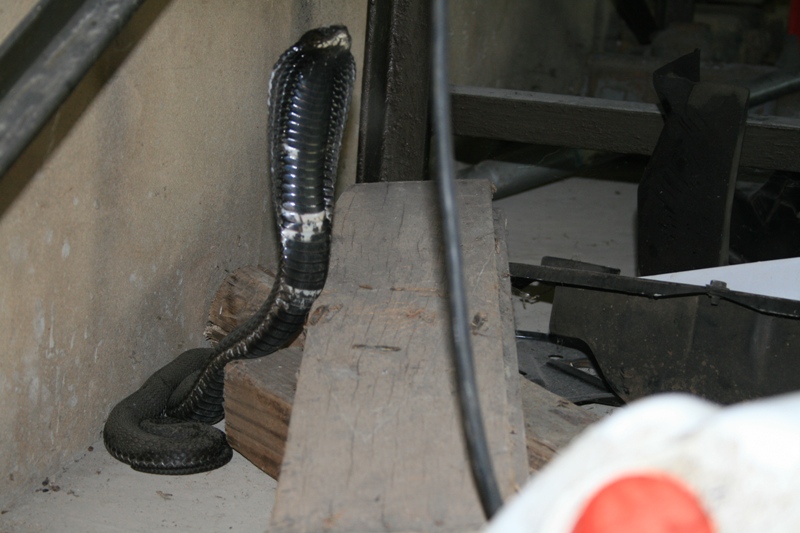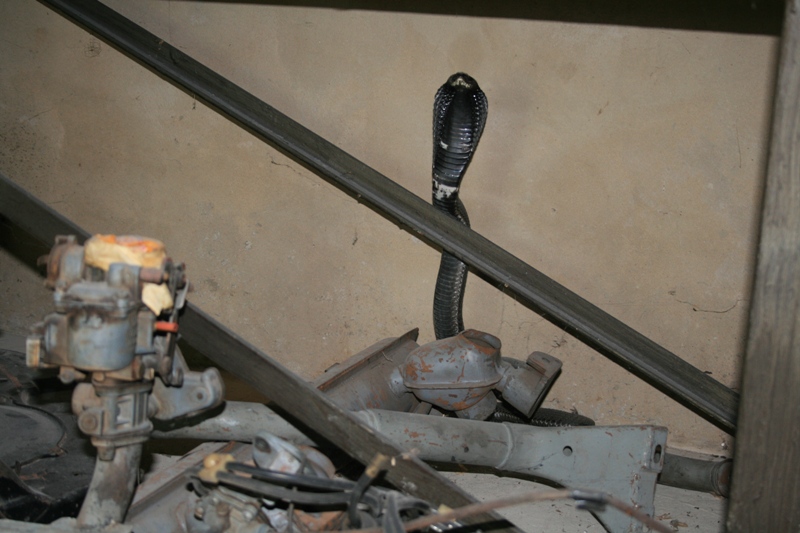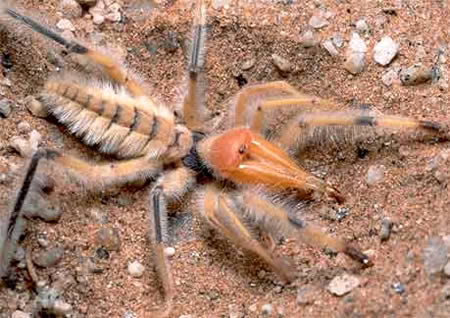Page 1 of 7
Look who moved in to my workshop
Posted: Sun Mar 14, 2010 3:42 pm
by fig
Look who I found under my work bench:


A
rinkals or banded spitting cobra (from Dutch
ring = ringed,
hals = throat).
I don't want to kill it, so I'm trying to catch it to release it elsewhere, but it keeps retreating behind the junk in my workshop. Right now I've closed up the workshop and have a bus running inside, in the hope that the fumes will persuade the snake to leave.
Re: Look who moved in to my workshop
Posted: Sun Mar 14, 2010 3:55 pm
by Pine
Wow! What a magnificent creature!
Re: Look who moved in to my workshop
Posted: Sun Mar 14, 2010 4:02 pm
by Pine
The Rinkhals also called the Ringhals or Ring-necked Spitting Cobra (Hemachatus haemachatus) is a venomous elapid species found in parts of southern Africa. It is one of a group of cobras that has developed the ability to spit venom as a defense mechanism.
Scale pattern and distribution
Scalation:
17 -19 Dorsal scales on the midbody
116-150 Ventrals
30-47 Subcaudals
Subscales are paired
Analscale is entire
7 Upper labials
3+4 Upper labials entering the eye
1 Preoculair (rarely up to 3)
3 Postoclurairs
8-9 Lower labials
Behaviour and diet
The Rinkhals has eclectic tastes. Its main prey is toads, but it also eats small mammals, reptiles and other amphibians. Like several other snakes, the Rinkhals is also known for its ability to play dead. The Rinkhal only hunts at night because it is hiding from the sun during the day.
Venom
The venom of the Rinkhals is neurotoxic and partially cytotoxic. The venom of this species is less viscous than that of other African elapids. It generally aims its venom at the face. If the venom enters the eyes it causes great pain.
Symptoms of a bite
Local symptoms of swelling / bruising is reported in about 25% of cases. General symptoms of drowsiness, nausea, vomiting, violent abdominal pain, cramps and vertigo often occur, as does a mild pyrexial reaction.
Defensive behaviour
When distressed the Rinkhals spreads its hood, showing its distinctive striped neck. The Rinkhals is a spitting snake, and can spray its venom (which is neurotoxic) up to 2.5m. It is also known to fake death by rolling onto its back with its mouth agape.
Habitat
The Rinkhals generally prefers grassland habitas because it makes them blend in with the surroundings. Rinkhals also my live in swamps around Southern Africa.
Interesting facts
- The Rinkhals is not in the same genus as other "true" cobras, it is in fact monotypic and not in the genus Naja. Nevertheless, many experts consider it to be one of the true "spitters" - as spitting goes among snakes.
- Rinkhals are unique amongst African cobras in being ovoviviparous. They give birth to 20-35 young, but as many as 65 babies have been recorded.
- The Rinkhals is unique also, compared to cobras, as it has keeled scales.
Re: Look who moved in to my workshop
Posted: Sun Mar 14, 2010 4:24 pm
by fig
OK, the fumes chased him out of the workshop into the room where I was woking on the PC!

But we pinned him down and now he's safely inside a drawstring bag. I'm off to release him on some open farmland nearby.
Re: Look who moved in to my workshop
Posted: Sun Mar 14, 2010 4:24 pm
by benjamin
W T F !!!!!!!!!!!!!!!!!!!!!!!!!!!!
Re: Look who moved in to my workshop
Posted: Sun Mar 14, 2010 4:59 pm
by fig
The snake is now safely in a wetland about 5km away. Hopefully that's far enough for it not to find its way back.
Re: Look who moved in to my workshop
Posted: Sun Mar 14, 2010 5:27 pm
by Chris
Good one!
I don't realy like killing them unless they become a real problem.
Re: Look who moved in to my workshop
Posted: Sun Mar 14, 2010 5:29 pm
by ZeroAxe
Chris wrote:Good one!
I don't realy like killing them unless they become a real problem.


Re: Look who moved in to my workshop
Posted: Sun Mar 14, 2010 6:11 pm
by mrsfig
fig wrote:The snake is now safely in a wetland about 5km away. Hopefully that's far enough for it not to find its way back.

Latest entry into my log book "Release snake - 10km"
Re: Look who moved in to my workshop
Posted: Sun Mar 14, 2010 6:13 pm
by mrsfig
Pine wrote:Wow! What a magnificent creature!
Yip! It was beautiful!!!.... And very pissed off!
Re: Look who moved in to my workshop
Posted: Sun Mar 14, 2010 6:21 pm
by mrsfig
While we were trying to catch the snake, it spit at me and I got a drop or 2 in my eye and a little on my face - but no problem - I just washed it off quickly, it burned a bit, but now it's cool

. A little excitement on a Sunday afternoon...

Re: Look who moved in to my workshop
Posted: Sun Mar 14, 2010 6:29 pm
by Pine
Mrs Fig wrote:Yip! It was beautiful!!!.... And very pissed off!
You mean: 'Pitttttttttttthhhhhhhed off?'

Re: Look who moved in to my workshop
Posted: Sun Mar 14, 2010 6:57 pm
by BARON
Im Sorry,
If you have a relative bitten by that bastard and the doctor say its the end of the road ,---nothing else he can do, there is no way you can see their beuty or reason for existance.
We kill several each summer season.
They go paralised when you spray them with an aerosol like Doom and you can pick them up by hand . Dont know if it is terminal or permanent but it doesnt matter to me.
O and look out for his partner because they travel in pairs and they move into cool dark places like your home or out buildings this time of year
cheers
Baron
Re: Look who moved in to my workshop
Posted: Sun Mar 14, 2010 7:19 pm
by Donovan D
fig wrote:
I don't want to kill it, so I'm trying to catch it to release it elsewhere,.
Reminds me of growing up on Langebaanweg Airforce base, we'd have the occasional scorpion or red roman spider(nasty looking things) get into the house, my dad would always catch it in a jar or tub and then slide some paper underneath to get it off the ceiling or ground and then release it in the veld nearby,never killed anything,
...while my mom was ready with the doom and shoe
Re: Look who moved in to my workshop
Posted: Sun Mar 14, 2010 7:37 pm
by Pine
Splitz wrote: red roman spider

Those a the CREEPIEST things to currently walk the face of this earth

...yet very intersting too
Solifugae is an order of Arachnida, containing more than 1,000 described species in about 140 genera. The name derives from Latin, and means those that flee from the sun. The order is also known by the names Solpugida, Solpugides, Solpugae, Galeodea and Mycetophorae. Their common names include camel spider, wind scorpion, jerrymuglum, sun scorpion and sun spider. In southern Africa they are known by a host of names including red romans, haarskeerders and baardskeerders, the latter two relating to the belief they use their formidable jaws to clip hair from humans and animals to line their subterranean nests.
Solifugae are not true spiders, which are from a different order, Araneae. Like scorpions and harvestmen, they belong to a distinct arachnid order. Solifugae are considered to be endemic indicators of desert biomes.
Solifugae are the subject of many urban legends and exaggerations about their size, speed, behavior, appetite, and lethality. They are not especially large, the biggest having a leg span of perhaps 12 centimeters (5 in).[3] They are fast on land compared to other invertebrates, the fastest can run perhaps 16 km/h (10 mph), nearly half as fast as the fastest human sprinter. Members of this order of Arachnida apparently have no venom, with the possible exception of one species in India (see below) and do not spin webs.
In the Middle East, it is widely rumored among American and coalition military forces stationed there that Solifugae will feed on living human flesh. The story goes that the creature will inject some anaesthetizing venom into the exposed skin of its sleeping victim, then feed voraciously, leaving the victim to awaken with a gaping wound. Solifugae, however, do not produce such an anaesthetic, and they do not attack prey larger than themselves unless threatened. Other stories include tales of them leaping into the air, disemboweling camels, screaming, and running alongside moving humvees; all of these tales are dubious at best. Due to their bizarre appearance many people are startled or even afraid of them. This fear was sufficient to drive a family from their home when one was discovered in a soldier's house in Colchester, England. The greatest threat they pose to humans, however, is their bite in self-defense when one tries to handle them. There is essentially no chance of death directly caused by the bite, but, due to the strong muscles of their chelicerae, they can produce a proportionately large, ragged wound that is prone to infection.




